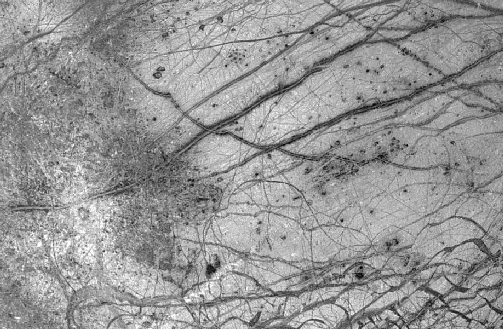Astronomy Picture of the Day
Discover the cosmos!
Each day a different image or photograph of our fascinating universe is
featured, along with a brief explanation written by a professional
astronomer.
August 14, 1996

Galileo Explores Europa
Credit:
Galileo Project,
JPL,
NASA
Explanation:
Details of the crazed cracks criss-crossing
Europa's frozen surface are apparent in this mosaic of
the Galileo spacecraft's latest images of Jupiter's ice-covered moon.
Curious white stripes, also seen by Voyager,
are clearly visible
marking the center of the wide dark fractures. One theory
suggests that "dirty geysers" erupting along the cracks deposited
darker material followed by a flow of cleaner water ice
which produced the stripe.
The above image also shows an impact
crater about 18.5 miles in diameter
surrounded by white ejecta (lower left) and a curving x-pattern
at bottom left which suggests fractures between icy plates
filled with slush frozen in place.
Is there now or was there ever
liquid water beneath
Europa's surface?
These latest results still hold out that possibility -- and so the
possibility of life.
Europa, along with Mars
and Saturn's moon Titan is
considered to be one of the few places in
our Solar System, beyond Earth,
where primitive life forms could have developed. Galileo's close
flyby of this tantalizing moon
is scheduled for December of this year.
Tomorrow's picture: Galileo Views Eruption on Io
| Archive
| Index
| Search
| Glossary
| Education
| About APOD |




Authors & editors:
Robert Nemiroff
(MTU) &
Jerry
Bonnell (USRA).
NASA Technical Rep.:
Sherri
Calvo.
Specific rights apply.
A service of:
LHEA
at
NASA/
GSFC




